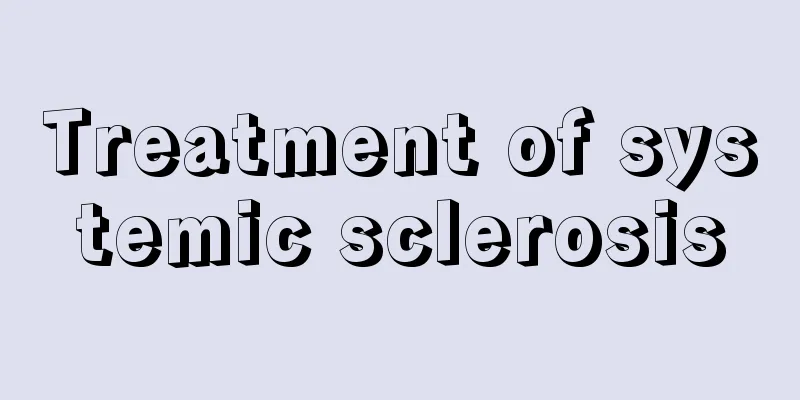Treatment of systemic sclerosis

|
Systemic sclerosis may sound unfamiliar to everyone. However, everyone may have an intuitive understanding of scleroderma. Systemic sclerosis is also called scleroderma. The incidence of this disease is not very high now, so everyone does not know much about it. However, the incidence rate is still relatively high among women of childbearing age, miners and silicone workers. Scleroderma is clinically known as systemic sclerosis, skin paralysis, muscle paralysis, and systemic sclerosis. The scleroderma topic of Doctor Online has a detailed explanation of the etiology and pathology, examination and testing, preventive health care, symptoms and signs, related complications, treatment and medication, etc., and provides a large amount of article information for your reading and reference. Scleroderma is a connective tissue disease characterized by localized or diffuse fibrosis, sclerosis and atrophy of the connective tissue of the skin and internal organs. Its main features are fibrosis or sclerosis of the skin, synovium, skeletal muscle, blood vessels and esophagus. Some internal organs, such as the lungs, heart, kidneys, and large and small arteries may also have similar lesions. Some patients only develop skin sclerosis, which is called localized scleroderma; while some patients also develop fibrosis and sclerosis of internal organs such as the heart, lungs, gastrointestinal tract and kidneys. This condition is called systemic sclerosis, which is often serious and has a poor prognosis. This disease ranks second only to lupus erythematosus among connective tissue diseases. Most patients are female, with a female to male ratio of approximately 3:1. The age of onset is mostly between 20 and 50 years old. The disease is most common in women of childbearing age, but children and the elderly can also develop the disease. There are reports that miners and workers exposed to silicon have more cases of scleroderma. Traditional Chinese Medicine Treatment of Systemic Sclerosis 1 Local injection of Chinese herbal extracts: 2 Acupoint moxibustion: 3. Chinese medicine vapor mist transdermal penetration therapy: The warm stimulation of the medicinal vapor increases the skin temperature, dilates the skin capillaries, and promotes the circulation of blood and lymph. Circulation, promote metabolism, and improve the nutrition of surrounding tissues. The warm stimulation of the medicinal vapor also opens the pores, causing sweating all over the body, allowing the "evil toxins" in the body to be discharged with sweat, which not only strengthens the body but also eliminates fatigue and gives people a sense of comfort. At the same time, it can stimulate the nerve endings receptors in the skin, form new reflexes through the nervous system, thereby destroying the original pathological reflex connection and achieving the purpose of curing the disease. As the medicinal vapor circulates from bottom to top, it also penetrates the acupuncture points and dredges the meridians (as the saying goes, "if the meridians are unblocked, there will be no pain, and if there is pain, the meridians are blocked"), so it can replenish qi and blood and regulate the balance of yin and yang in the body. The use of appropriate steam therapy equipment can make the treatment process an enjoyable "sauna" process, which helps to eliminate the patient's tension and discomfort, improve the patient's acceptance of drug treatment, and mobilize the patient's autonomous "positive energy" to fight and cure diseases from the "psychological" and "consciousness" levels. It truly realizes the dream of “making good medicine no longer bitter and making treatment a pleasure”. 4. Meridian acupoint injection method: Use self-developed Chinese medicine for meridian acupoint injection. Systemic sclerosis, also known as scleroderma, is very distant and unfamiliar to us. It can be easily avoided as long as we do a good job of prevention and avoid contact with certain chemicals that irritate the skin. However, especially in high-risk groups, we must take it seriously, diagnose it in time when symptoms occur, and take effective methods for treatment. |
<<: Is frequent stomach pain and acid reflux after meals due to gastritis?
>>: What is the best way to treat periodontitis?
Recommend
What disease is it that causes constant burping and farting
Hiccups, farts, yawns... these little embarrassme...
Causes of abo hemolysis disease
Many people want to fully understand the cause of...
What should I do if a mosquito bite leaves a red mark?
The summer when mosquitoes are rampant is very sa...
How long can raw chestnuts be kept
Autumn is the season when chestnuts are on the ma...
Will it be contagious if I live with a stomach cancer patient?
Cancer is a relatively stubborn disease. If it is...
What to do if the skin hurts due to sunburn
In the hot summer, we still have to go out to wor...
The benefits of drinking more water and urinating more
Every adult should drink a certain amount of wate...
Can diabetics drink snow chrysanthemum? Dietary principles for diabetics
There are many dietary considerations for diabeti...
What are the functions of a steam room?
Many people who pay more attention to health pres...
Will cervical cancer seriously affect sex life? Do I need to have regular checkups to prevent cervical cancer?
What are the dangers of cervical cancer? Cervical...
What to do if the pores on your arms are clogged
It is the hottest time of summer, and wearing coo...
What are the sequelae after pituitary tumor surgery
With the aging of society, young people are under...
What tests should be done for brain cancer
Many brain cancer patients lose their lives in th...
Traditional Chinese Medicine Treatment for Advanced Pancreatic Cancer
In recent years, the incidence of pancreatic canc...
How many courses of radiotherapy are there for nasopharyngeal carcinoma
How many courses of radiotherapy are there for na...









